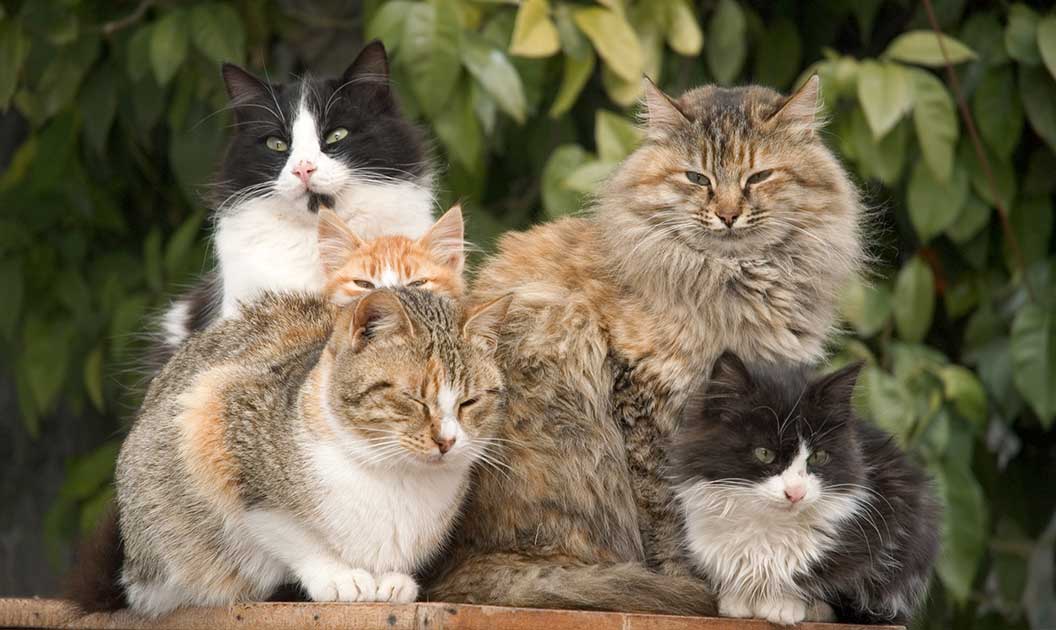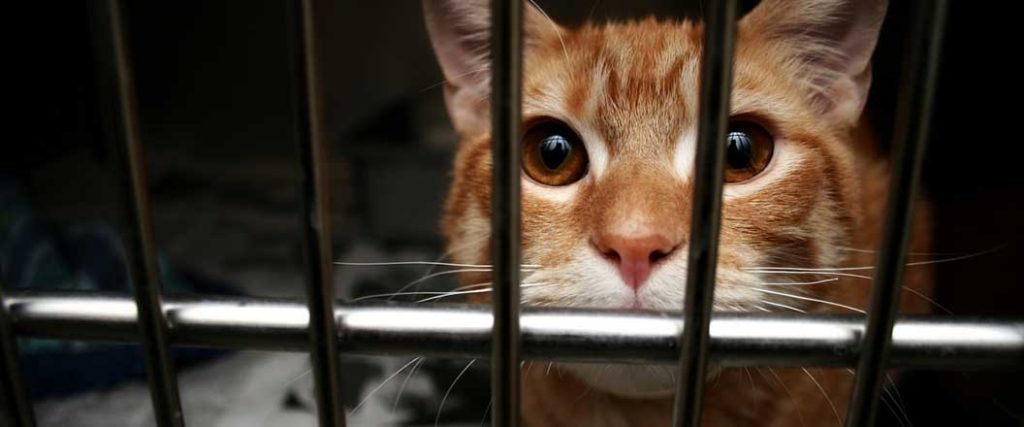TNR Program for Cats: Helping Feral Felines in Communities

TNR programs for cats typically come up when discussing solutions to the issue of stray and feral cats. It’s a relatively new approach, but the ultimate goal of VOCAL as well as other rescue organizations that run such programs, is to safely and humanely control feral cat colonies while also eliminating the spread of disease.
TNR stands for Trap-Neuter-Return, and it’s a way to manage stray cat populations. Instead of catching and killing cats indiscriminately, TNR programs focus on sterilization. The idea is to stabilize the cat population and prevent new litters from being born. Combined with removal and adoption efforts, success is possible.
Find out more about our feral cat TNR programs in Ocala, FL and how we can make our efforts successful by working together as a community.
Table of Contents
What is a TNR Program For Cats?
TNR (Trap-Neuter-Return) programs seek to find a humane and effective way to manage outdoor cat populations. Please note, although population management seems to imply that we are content with homeless cats remaining in the community – this is NOT the case.
Feral cat TNR programs, like the one at VOCAL, are simply one tool in our ongoing efforts to improve pet welfare across the board. We recognize that it’s an uphill battle some days. Between the rate at which cats reproduce to the terrible practice of pet abandonment, there are those who would give up.
At VOCAL, we prove that it’s possible to succeed with each cat that’s treated.
In order to achieve a better life for pets and maintain a safer and healthier community for people, we carry out our TNR program with qualified veterinarians and committed volunteers.
Understanding How TNR Programs Work
The management of stray and feral cats is an ongoing process that has financial, health, and ethical implications.
Any animal control program must be cost-effective enough to enact on a large scale. Homeless pets can’t just be ignored, since unmanaged populations of strays, both dogs and cats, do pose serious health risks by way of spreading disease.
To be ethical, humane practices that avoid prolonged suffering for the animal and undue emotional distress for people, should be used.
A well-run TNR program checks off each point. It’s a community-based approach to controlling outdoor cat populations in a way that doesn’t overburden animal services and helps make inroads into reducing animal in-take into shelters in the long term.
To be sure, success requires a high-intensity, high-volume approach on the front end. That’s where members of our community can play a part in making a difference.
VOCAL seeks to partner with a number of other organizations in Marion County and North Central Florida to make their TNR program successful. We also follow a strict set of rules.
Each cat going through the program gets the following:
- A spay or neuter surgery performed by a qualified veterinarian
- A rabies vaccine to prevent the spread of disease
- Ear tipping to allow those overseeing cat colonies to identity sterilized individuals
- A dose of flea medication to reduce external parasites
Done consistently, this approach proves to be an effective solution when planning for long-term success.

Is TNR Legal in Ocala, FL?
Yes, TNR is legal in Ocala, FL. In fact, the city has a special ordinance that allows for the humane management of community cat populations. Marion County, FL Code of Ordinances, Ch. 4 – Sect. 4.20 outlines the community cat initiative.
Community cat is the legal term Ocala uses to define feral strays. It gives programs like VOCAL the legal backing to help get cats spayed or neutered, vaccinated, and ear-tipped to indicate that they have been sterilized.
By helping the county achieve their TNR goals, we can successfully reduce the outdoor cat populations while improving their health and well-being.
Another beneficial side effect is to reduce the number of cats entering animal shelters and save taxpayer dollars. As the program goes in, it’s been proven that TNR programs that focus on sterilization and return end up costing less than programs which shelter, euthanize, and then must dispose of the animal.
What are the Statistics on the Effectiveness of TNR Programs for Cats?
TNR programs, referred to as Shelter-Neuter-Return (SNR) through Marion County Animal Services, have become increasingly popular as a humane and effective way to manage feral cat populations.
That said, there are a number of concerns that those hestitant about the program sometimes have.
- Is there proof that TNR methods actually reduce or stabilize cat colonies?
- Aren’t rescues wasting their time and resources on animals that can’t be rehomed?
- Are released cats really better off than their euthanized counterparts?
These are questions worth looking into, if only so we can show you that not only do TNR programs for cats work, but they are positively impacting the Ocala community and surrounding areas.

Is TNR better than Euthanasia?
According to a case study conducted by the University of Southern Maine, TNR programs have been shown to be more effective than euthanasia at managing feral cat populations and saving municipalities’ money at the same time.
One way used to measure TNR success in the study was to track the number of euthanasia procedures performed by animal shelters.
Euthanasias in shelters are primarily reduced when two things happen:
- Increased adoptions
- Reduced intake
For the case study, they found that the TNR program actually accounted for an 80% decrease in the euthanasia rate, compared to a 20% decrease attributed to adoptions. As far as finances went, it meant that for every $1 being spent, $3 dollars were being saved within the animal control budget compared to the previous system that lacked a TNR initiative.
A separate simulated projection using real world data conducted by the Alliance for Contraception in Dogs and Cats and published in the Journal of Feline Medicine and Surgery also found TNR to be financially efficient and effective in population management. Success hinged largely on a high-intensity approach maintained over enough time.
Within just 10 years, a well managed TNR program can reduce the homeless cat population by 45% or more. As the program continues, that number continues to improve as birth rates drop and older cats pass away. That’s potentially millions of cats being kept from living feral.
In short, it is possible to stabilize and reduce the presence of cat colonies through TNR. In the long-term, it is also more cost-effective than euthanasia. This means that even though the cats aren’t often rehomed, it certainly isn’t a waste of resources.
What about the cats themselves? Is sending them back into the streets really the best thing? Quite honestly, there is no simple answer to this.
Homeless cats are subject to a wide variety of dangers:
- Being hit by cars
- Disease and parasite infestations
- Potential food shortages
- Injuries from fights with other cats and animals
- Human cruelty
There really isn’t a great way to sugarcoat these issues. However, there is also evidence that a healthy feral cat can live comfortably in the wild. Cats are resourceful animals with a knack for thriving despite hardships.
At the end of the day, these dangers are the reason for VOCAL’s efforts to improve pet welfare across the board. Fewer births will reduce the population. Educating the community and providing low-cost veterinary care options reduces the rate of pet abandonment.
For VOCAL, the goal is improvement of animal welfare. Should a cat be brought into our clinic and found to have injuries or a disease that can’t be managed, our vets will recommend humane euthanasia. On a case by case basis, some may even be considered for adoption.
We continue to encourage and support our TNR participants as they work to safely trap and bring in colony cats. For our program to work, mass sterilization is the goal.
Our volunteers and partners are committed to making that goal a reality.
Find Solutions Through VOCAL’s Community Clinic in Ocala
If you are living in Marion County, Florida, and looking for a TNR program for feral cats, you can find solutions through VOCAL’s Community Clinic and Resource Center located in Ocala.
VOCAL’s mission is to reduce the homeless pet population and improve animal welfare, and they offer a range of services specific to those looking to participate in TNR programs.
Additionally, we provide appointments for low-cost spay and neuter surgeries for personal pets, both dogs and cats.
Other services include:
- Drive thru vaccine clinics
- Low-cost dental cleanings for dogs and cats
- Options for purchasing flea and tick prevention
- Microchips
To take advantage of these services, you can pre-register online and select the services and date where you would be able to bring your pet.
While spay and neuter surgeries are performed throughout the week on set days, the drive-thru clinics are only held once a month. We regularly update the dates on our drive thru-clinic page, so you can plan for the month that best fits your schedule.

Where Can I Find a TNR Program for Feral Cats Near Me?
VOCAL’s Community Clinic in Ocala offers spay/neuter operations specifically for feral cats.
We’re located at:
6391 SW 52nd St.
Ocala, FL 34474
Contact VOCAL today by submitting a program services form.
Spay and neuter procedures for feral cats are offered at a special rate of $35 per animal.
The procedure includes a rabies vaccine, ear-tipping, and a dose of flea prevention. If you aren’t able to participate in this program by physically bringing in cats, you can still make a difference by donating the cost of a procedure.
These donations allow us to help cat colony caregivers expand their efforts to bring in and sterilize as many cats as possible.
Are there any cat trapping services available for TNR programs?
VOCAL’s Community Clinic in Ocala may be able to help you with cat trapping as well. There are humane traps available for rent, and we can provide guidance on how to safely and effectively trap feral cats.
We want to provide help for those who are new to TNR programs and may not have experience with trapping cats.
Overall, if you are looking for a TNR program for feral cats in Marion County, Florida, VOCAL’s Community Clinic in Ocala is a great resource. They offer a range of services specifically tailored to those looking to help us solve the problem of homeless pets.
Embrace Humane Solutions With TNR Programs For Cats Through VOCAL
TNR programs offer a compassionate and effective approach to manage feral cat populations. Through sterilization, vaccination, and identification, we can ensure that these community cats live healthier lives without adding to the stray problem.
Moreover, cities like Ocala, FL, are recognizing the importance of such initiatives, making them legal and supported by local ordinances. Research, too, stands by the efficacy of TNR over other methods, emphasizing not just the humane aspect, but also the cost-effectiveness.
Take Action Now: Support VOCAL in their mission.
If you come across a stray or feral cat, reach to VOCAL for help with this form. Together, we can create a safer, more humane world for these feline friends.